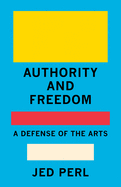
Jed Perl is too diplomatic to put it so bluntly, but he's had it up to here with the idea that the success of a work of art--a painting, a song, a play, a poem--should hinge on its messaging. Authority and Freedom: A Defense of the Arts is Perl's measured but emphatic case for art for art's sake, and a dissection of the long battle between the two abstract nouns that give his book its title.
Across six modest chapters, the author outlines the tension between an artist's hunger for total freedom and the pressure exerted on the artist to demonstrate an allegiance to authority, which Perl defines, paraphrasing philosopher Hannah Arendt, as "a hierarchy of values about which a group of people agree." Perl is generous with examples showing how this conflict has played out--with critics, with art lovers--across the generations. Of Picasso's 1937 masterwork, Perl writes, "Guernica is almost universally accepted as an indictment of humanity's inhumanity," and yet "for those who admired the mural, the key to its greatness was precisely Picasso's rejection of a journalistic or propagandistic approach."
A seasoned art critic and a biographer of Alexander Calder, Perl isn't remotely a dry or humorless writer, but Authority and Freedom will likely speak most clearly to those who have some grounding in art history or appreciation. Perl is adamant that art has no obligation other than to dazzle us, and his book is itself beautifully made, its ideas both authoritative and, intellectually speaking, freeing. --Nell Beram, author and freelance writer

